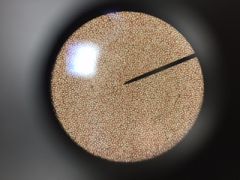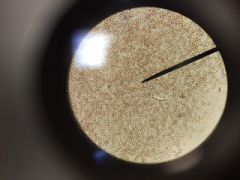![]()
![]()
![]()
Use LEFT and RIGHT arrow keys to navigate between flashcards;
Use UP and DOWN arrow keys to flip the card;
H to show hint;
A reads text to speech;
31 Cards in this Set
- Front
- Back
|
Selective (differential) permeability |
Plasma membrane is selective about what passes through it. Allows nutrients to enter cell but keeps out undesirable substances. Valuable cell proteins and other substances are kept within the cell, and excreta or wastes pass to the exterior. |
|
|
Passive Processes |
Concentration or pressure differences drive the movement |
|
|
Active Processes |
Cell provides energy (ATP) to power the transport process |
|
|
Two types of Passive Processes |
Diffusion |
|
|
Diffusion |
Important transport process for every cell in the body |
|
|
Filtration |
Usually occurs only across capillary walls |
|
|
Diffusion |
When a concentration gradient (difference in concentration) exists, the movement of molecules from a region of their higher concentration to a region of their lower concentration |
|
|
Simple diffusion |
Unassisted diffusion of solutes (dissolved substances) through a selectively permeable membrane |
|
|
Facilitated diffusion |
Substances moving by a passive transport process from high to low concentration Example: Glucose are transported across the plasma membrane with the assistance of a protein carrier molecule |
|
|
Osmosis |
Flow of water across a selectively permeable membrane down its concentration gradient |
|
|
Filtration |
- Passive process in which water and solutes are forced through a membrane by hydrostatic (fluid) pressure - Not selective - amount of filtrate (fluids and solutes) formed depends almost entirely on the pressure gradient (difference in pressure on the two sides of the membrane) and on the size of the membrane pores |
|
|
Active Processes |
- Whenever a cell uses the bond energy of ATP to move substances across its boundaries |
|
|
Substances moved by active means |
- May not be lipid soluble - May be too large to pass through membrane channels - May have to move against rather than with a concentration gradient |
|
|
Two types of Active Processes |
Active Transport Vesicular Transport |
|
|
Active Transport |
- Requires carrier proteins that combine specifically with the transported substance - Substances move against concentration or electrochemical gradients or both |
|
|
Vesicular Transport |
- Fluids containing large particles and macromolecules are transported across cellular membranes inside membranous sacs called vesicles |
|
|
Vesicles |
- Membranous sacs that transport fluids containing large particles and macromolecules across cellular membranes |
|
|
Endocytosis |
- Vesicular transport moving substances into the cell |
|
|
Exocytosis |
- Vesicular transport moving substances out of the cell - Used for hormone secretion, neurotransmitter release, mucus secretion and ejection of wastes |
|
|
3 Types of Endocytosis |
Phagocytosis Pinocytosis Receptor-mediated Endocytosis |
|
|
Phagocytosis |
- "Cell Eating" - Cell engulfs some relatively large or solid material (Ex: clump of bacteria, cell debris, inanimate particles) |
|
|
Pinocytosis |
- "Cell drinking" - Also called Fluid-phase "endocytosis" - Cell "gulps" a drop of extracellular fluid containing dissolved molecules - Routine activity of most cells |
|
|
Secretory Vesicle |
- Protein coated vesicle that transports substances within the cell |
|
|
Red and white blood cells. Isotonic Solution. Cells retain their normal size and shape. |

|
|
|
Red and white blood cells. Hypertonic Solution. Cells lose water by osmosis and go through crenation. |

|
|
|
Red and white blood cells. Hypotonic Solution. Cells take on water by osmosis and swell to burst. Hemolysis, or lysis. |

|
|
|
a. reflects the kinetic energy of molecules d. is random and erratic |
Molecular motion reflects the kinetic/potential energy of molecules and is ordered/random and predictable/erratic. |
|
|
b. is lower in larger molecules c. increases with increasing temperature |
Speed of molecular movement is lower in smaller/larger molecules and increases with decreasing/increasing temperature |
|
|
Size of pores. Solubility in the lipid portion of the membrane and/or presence of membrane “carriers” for the substance(s). |
What single characteristic of the differentially permeable membranes used in the laboratory determines the substances that can pass through them? In addition to this characteristic, what other factors influence the passage of substances through living membranes? |
|
|
Passive Transport |
- account for the movement of fats and respiratory gases through the plasma membrane - include osmosis, simple diffusion, and filtration - use hydrostatic pressure or molecular energy as the driving force |
|
|
Active Transport |
- explain solute pumping, phagocytosis, and pinocytosis - may occur against concentration and/or electrical gradients - move ions, amino acids, and some sugars across the plasma membrane |

